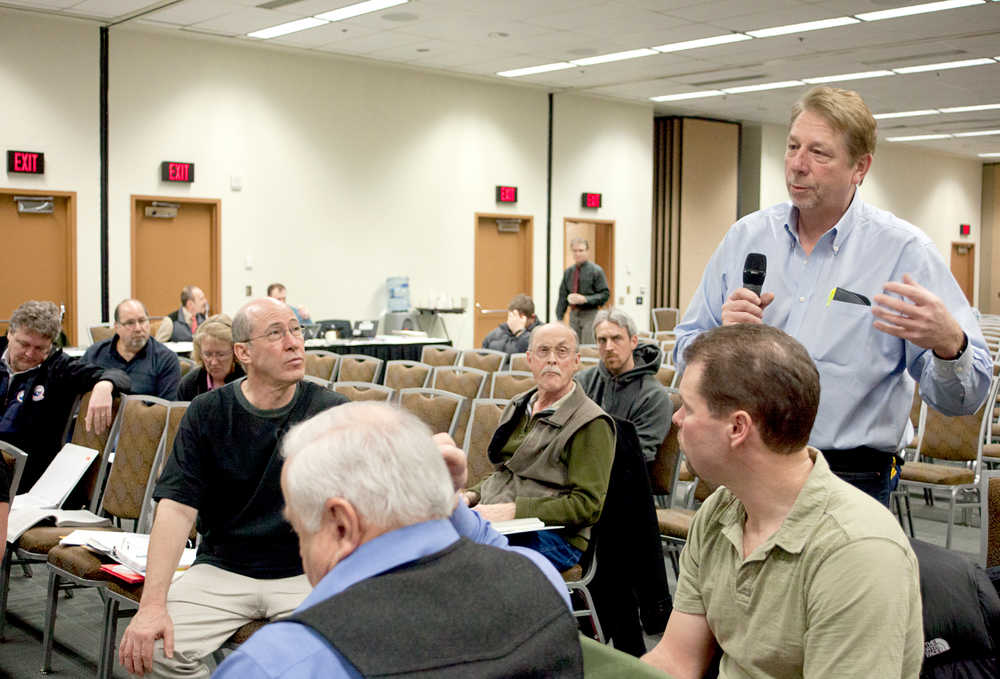The Alaska Board of Fisheries passed three measures Thursday, each restricting sportfishing on the Kenai River with the aim of conserving the early run of Kenai king salmon.
Slot limits
The first measure passed increases the slot limit size requirement on early run kings by four inches, expanding it to include fish from 42-55 inches long.
The move will keep anglers from harvesting a larger part of the early run of king salmon.
A slot limit was introduced on the Kenai River in 2002 to protect a certain size of fish from being harvested.
Alaska Department of Fish and Game managers break the early run of king salmon into five “age classes,” and further segregate those fish into percentages of the run — generating an estimate of how many fish of a certain age enter the river each year.
When the slot limit was introduced to the Kenai river in 2002, ADFG managers and the public had noticed a steep decline in the number of older-aged, larger king salmon returning to the river in the early run, according to the proposal submitted by sportfishing guide Greg Brush.
The slot limit was introduced to keep anglers from harvesting 5-ocean kings, or 7-year-old fish that spent two years in freshwater and five in the ocean, while still allowing harvest on other age-classes of the fish that were not in decline.
While ADFG took a neutral position on the proposal, the current slot limits have allowed the Fish and Game staff to conserve the large-size early run king salmon by eliminating the sport harvest of those fish, according to ADFG staff comments on the proposal.
The new slot limit is expected to protect 92 percent of 5-ocean king salmon in the early run and 49 percent of the 4-ocean female king salmon, according to ADFG data.
Monte Roberts, a sportfishing guide who primarily fishes the Kenai River, said he was opposed to the expanded slot limit.
“It takes a section of the population out of play that’s not — according to the department — in jeopardy,” he said. “This has changed from a conservation concern for five-ocean kings into a management tool to take a section of the fish out of the harvest.”
Roberts said, and ADFG data shows, 4-ocean kings to make up the largest component of the early run of Kenai king salmon.
However, U.S. Fish and Wildlife service 2013 fish-count data from the early run showed almost 80 percent of the run to be composed of young adult male fish — typically called jack kings — and ADFG managers said they would be changing their netting program during the 2014 season to account for younger, smaller fish that are swimming behind the sonar counters and could be skewing age-class data.
Roberts said the early run of Kenai king salmon was currently returning in low numbers, but the slot limit could be problematic when runs returned in higher numbers.
“They took the largest component of the run out of play, we won’t be able to harvest enough of the run to meet the escapement goal,” he said. “We’re going to have lost opportunity and wasted fish.”
Slikok Creek
The second group of proposals passed by the board expanded a sanctuary area around the mouth of Slikok Creek and added more than two miles of river to a geographical area bound by early-run king salmon conservation measures when the river enters late run king salmon management in July.
ADFG managers submitted the first proposal which established the lower boundary of the Slikok Creek king salmon sanctuary as the lower bound for standard regulations and emergency order actions in July — the former boundary was the Soldotna Bridge.
The 2.5 mile addition expands the area of the river subject to the early run slot limit and prohibition of bait from July 1-14 — though the late run of Kenai king salmon which technically starts on the Kenai River on July 1 is not always bound by those restrictions.
“We started coming down to the area below Slikok Creek because of the weir counts that we were seeing there,” said Jason Pawluk, assistant area management biologist for ADFG. “So our concern was trying to do everything we could when we had low early runs and we extended the restrictions to protect that particular stock.”
The extension will affect sport fishers who fish from the bank at Soldotna’s Centennial Park, a popular summer sport fishing spot.
The sanctuary area around Slikok Creek was expanded to include an additional 200 yards of the river upstream of the current area.
From Jan. 1-July 31 the area is closed to king salmon fishing, closed to sport fishing from a boat and is fly-fishing only water.
The Kenai Area Fishermen’s coalition submitted the proposal and ADFG managers supported it based on radio-tagging data that showed a Slikok Creek-bound king salmon swimming for an extended period of time in the area now protected by the expanded sanctuary.
Reach Rashah McChesney at rashah.mcchesney@peninsulaclarion.com.

